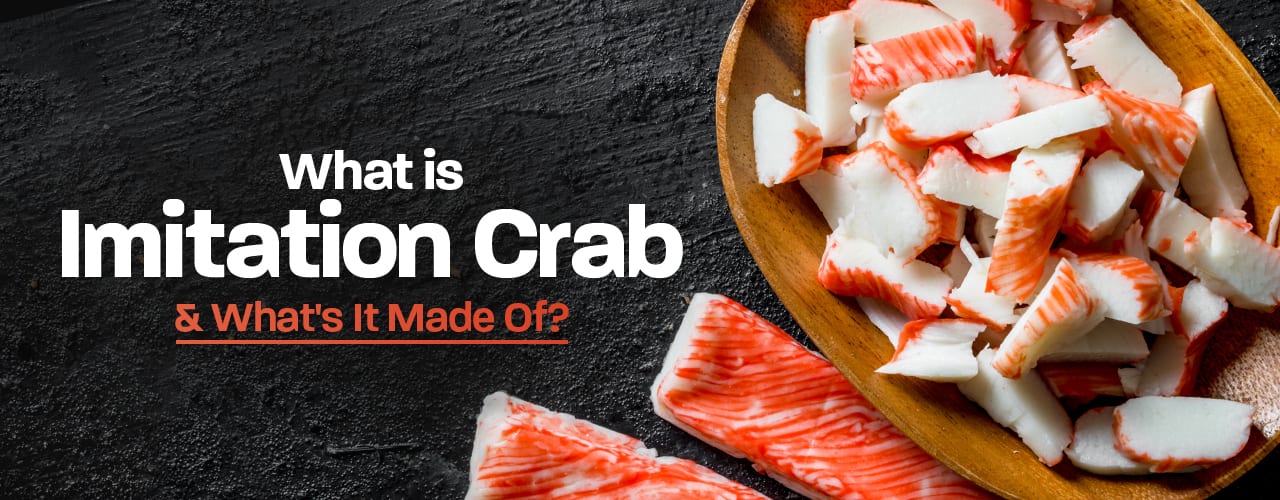What Is Imitation Crab?
Last updated on Dec 31, 2025Janine JonesImitation crab, also known as “krab” or “crab sticks,” is a type of seafood made from white fish and starch that is molded to resemble and taste like snow or spider crab meat. It was invented in 1974 by Sugiyo Co. of Japan under the name “kanimam” and is now consumed around the globe. You’ll find imitation crab most commonly used in sushi rolls and seafood salads.
There is a generally unfavorable reputation associated with imitation crab, and many consumers consider it fake meat. We’ll explore how imitation crab is made, how it compares to real crab, and its benefits and downsides.
What Is Imitation Crab Made Of?

Imitation crab is made of a white fish paste called surimi, starches, egg whites, salt, sugar, and crab flavoring or a few bits of real crab just to achieve the right flavor. The ingredients list may vary depending on the recipe of the manufacturer.
What is Surimi?
Surimi is a white fish paste that is typically made from demersal fish (fish that live near the seafloor) like wild Alaska pollock, Atlantic cod, haddock, hake, and others. The fish is first deboned and washed, then minced into a paste. Seasonings and other ingredients are often added to surimi so it can be molded for imitation crab, fish sticks, fish patties, and fish cakes.
In Japan, these surimi-based foods are called kamaboko. Chefs in Asian countries have been using surimi for over 900 years, but it only gained popularity in the United States in the 1970s with the introduction of imitation crab.
How is Imitation Crab Made?
To make imitation crab, white fish is formed into the paste known as surimi. Binding ingredients such as egg whites, wheat, and starch, along with salt, vegetable oil, sugar, crab flavoring, and occasionally MSG are then added to the surimi. The paste is heated and pressed into rods resembling crab leg meat. Red and orange food coloring is applied to the outside of the rod to mimic the coloring of cooked crab. The meat is usually vacuum sealed and pasteurized at this point to prevent harmful bacteria and allow it to be eaten straight from the package.
How to Use Imitation Crab

Since imitation crab is precooked, you’ll find a wide variety of imitation crab recipes that you can add to your menu. Here are some of the top uses for imitation crab:
- California rolls and other sushi roll options
- Crab salad
- Crab cakes
- Crab rangoons
- Seafood pasta dishes
- Seafood dips
Is Imitation Crab Bad for You?
Although imitation crab does not have the same nutritional value as real crab, it is not considered bad to consume unless you are allergic to the ingredients in the blend. We compare the difference between imitation crab and real crab below.
Imitation Crab vs Real Crab
When comparing imitation crab to real crab, you’ll find that real crab is more nutritious than imitation crab in many ways. Real crab is higher in Omega-2 fatty acids, Vitamin B12, selenium, and zinc than imitation crab, and it has almost 3 times the amount of protein.
While imitation crab typically has added carbs from starch, which real crab does not have, it does tend to have less sodium than real crab (depending on the brand). Although both versions have similar calorie values, 85% of real crab’s calories come from protein while 61% of imitation crab’s calories come from carbs.
Benefits of Imitation Crab

Even though real crab is more nutritious, there are some perks to using imitation crab in your recipes.
- Affordability - Imitation crab is typically a third of the cost of real crab, making it a good choice if you're looking to add seafood to your menu while saving room in your budget.
- Pre-packaging - Because imitation crab is pasteurized and vacuum sealed, it can be served directly from the package without further preparation.
- Versatile - Imitation crab can be eaten on its own as a snack on the go or added to salads, soups, sushi rolls, dips, and more.
- Variety - Since imitation crab is manmade, there can be variations in the recipes between brands so customers can find the right blend for their needs. You can find versions that are gluten free, low in sodium, MSG free, or made with more natural ingredients such as cane sugar and sea salt.
Downside of Imitation Crab
Selecting imitation crab over real crab is certainly cost effective, but it can come with some downsides.
- Additives - Some consumers choose to avoid imitation crab because of the artificial ingredients and additives that it can contain, like added sugar, MSG, sodium, and food coloring.
- Allergens - Although there are regulations in place to make sure ingredients are properly listed on food products, some imitation crab products do not have adequate allergen identification. Because surimi is made with a blend of ingredients, those individual ingredients, like fish types and binding agents, may not be listed on the packaging.
- Environmental impacts - With pollock being the main ingredient for the surimi used in imitation crab, there have been threats of overfishing to the pollock population, disturbing the food chain. The production of surimi has generated a high volume of water waste, which can contaminate the oceans if not treated.
Because of its convenience and accessibility, it's no surprise that imitation crab has become the more popular choice over real crab. The imitation crab industry is currently a $1 billion industry and rising. If you're looking for a replacement to real crab in order to save time and money, imitation crab may be a good fit for your business.



